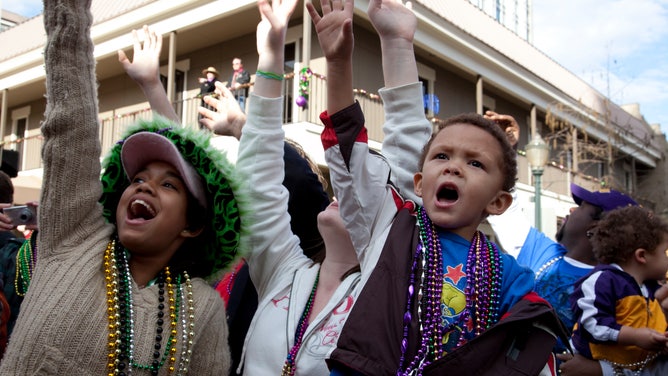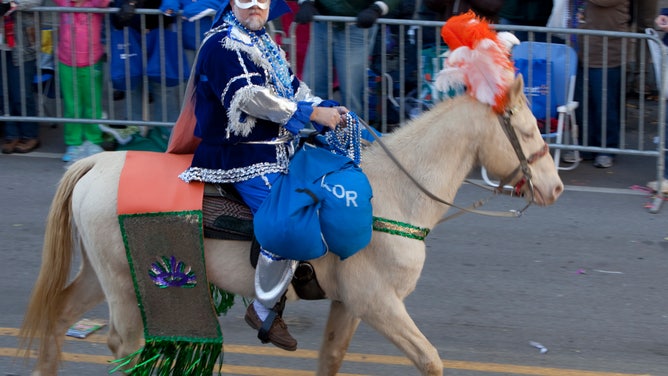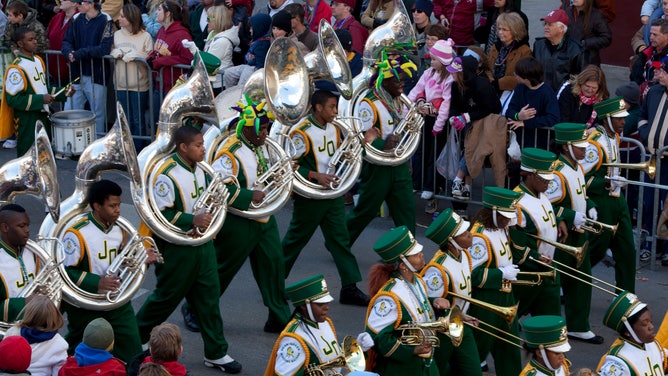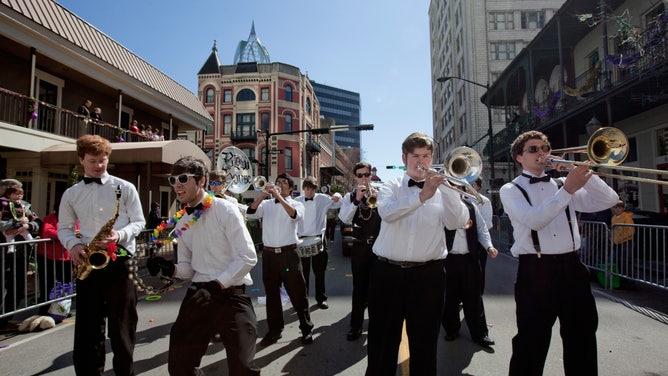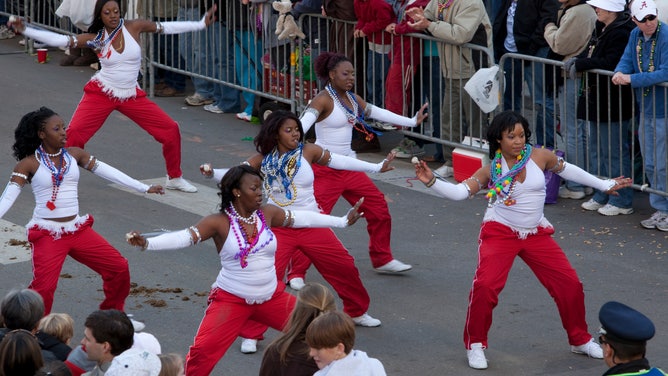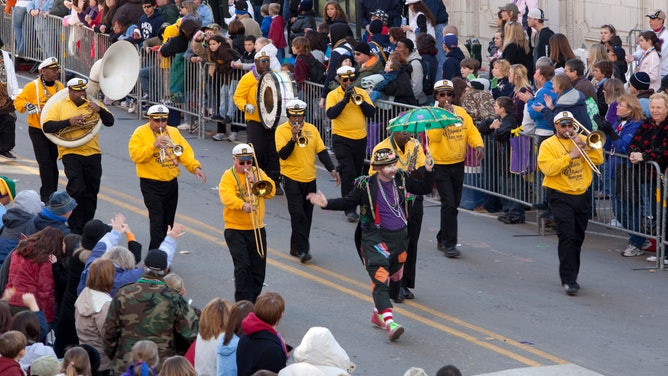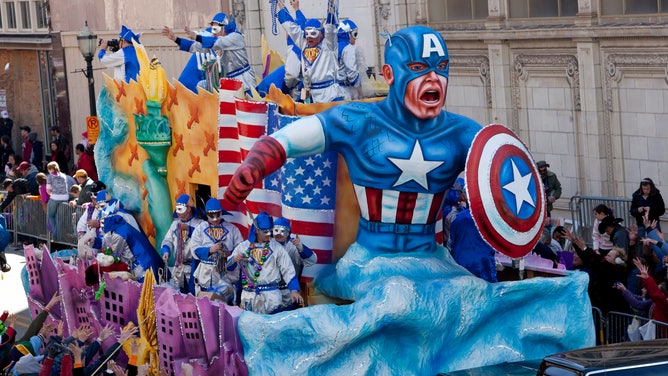How the first American Mardi Gras was in sweet home Alabama
Centuries ago, the city of Mobile created the template for the nation's Mardi Gras celebrations.
America's original Mardi Gras actually hosted in Mobile, Alabama
David Clark, President of Visit Mobile, joins FOX Weather to talk about the history of Mardi Gras and how the city was the first to host it.
When people think of Mardi Gras, they may think of parades and masquerade balls in New Orleans.
But before the first krewes floated down the streets of the Bayou State, another city just two states away became America’s gateway for Mardi Gras and the larger Carnival season.
Mobile, where Alabama dips its toe into the warm Gulf waters, kicked off what has become one of the country’s most celebrated cultural institutions.
Liberté, egalité, fraternité

A patriotic float moves down the street during Mardi Gras in Mobile.
(Carol M. Highsmith/Buyenlarge / Getty Images)
"In general, Carnival is happiness — it makes everyone happy," said Cart Blackwell, the curator of the Mobile Carnival Museum in Mobile, Alabama.
Carnival is a weeks-long celebration rooted in the Catholic church, with a start date that varies from city to city.
"Mobile’s Carnival season begins at the end of Thanksgiving, and it goes all the way through the early hours of Ash Wednesday morning," Blackwell said.
The eve of Ash Wednesday is Fat Tuesday — or better known as Mardi Gras.
According to Blackwell, Mardi Gras, Ash Wednesday and the larger Carnival season came to Mobile with the arrival of French colonists many centuries ago.

French explorer Pierre Le Moyne d'Iberville was one of the founders of Mobile, Alabama.
(Centre d'archives de Montréal. Bibliothèque et Archives nationales du Québec, Fonds Armour Landry, P97)
The French brought with them many traditions. One of which was their Catholic faith, which honors Carnival.
As these new Americans celebrated this old tradition, some added a little Gulf twist to it — starting on one New Year’s Eve.
The Cowbellion de Rakin Society
According to the University of Alabama (UA), the earliest American Mardi Gras celebrations took place in Mobile in 1699 and 1703.
"While we will never know the early [Mardi Gras] celebrations in the 18th century, what form they took in Mobile, New Orleans and Pascagoula — the three oldest French-founded cities on the Gulf Coast — we do know that in 1830, four Mobile men went out on the Mobile River," Blackwell said.
"And when four Mobile men go out on the river, we know there's a fifth one and it's called Jack Daniels."
According to Blackwell, this New Year’s river jaunt was headed by a gentleman named Michael Kraft.
After Kraft and his friends returned to the city, Kraft grabbed cowbells and rakes from a local hardware store and proclaimed himself the chief of the Cowbellion de Rakin Society — a play off of his recently acquired wares.
A night that began in jest later became the spark of an American tradition.
Creating the Template
Over the course of 1830, Kraft and other members of his newly formed Cowbellion de Rakin Society planned their next New Year’s Eve celebration.
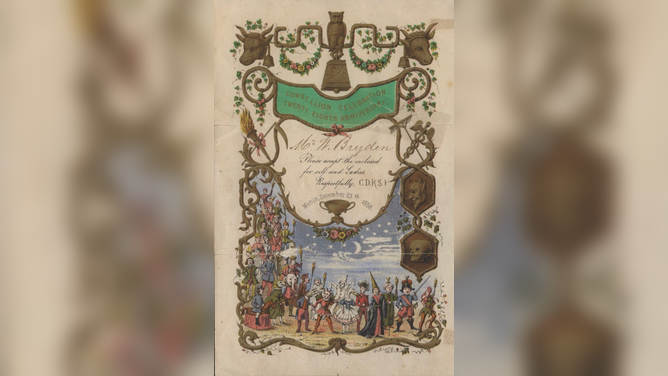
Mardi Gras invitation for the Cowbellion de Rakin Society in 1858. The Society was founded in 1830.
(Mobile Public Library / Local History & Genealogy)
"They chose a theme and they commissioned floats. They had costumes made that tied to the theme," Blackwell said. "They had descriptions printed in Mobile papers describing an upcoming parade of the Cowbellion de Rakin Society, and people went to see this parade."
He added that the Society also sent out invitations to a Cowbellion de Rakin Society ball.
"So, on New Year's Eve of 1831, you have the two ingredients that define American Carnival — with Mardi Gras at its height — established in Mobile," Blackwell said.
"A parade according to a theme with costumes that tie into the theme — and the parade’s for everybody to see. What follows is an invitation-only ball with a tableau or theatrical performance that ties to the theme for invited guests and members alone."
From there, the Carnival celebrations continued to grow in Mobile.
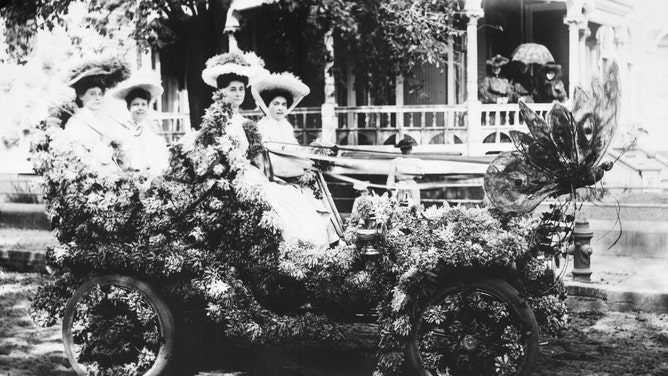
Four young ladies in flower decorated car for the Floral Parade at Mobile's Mardi Gras in 1905.
(Bettman / Getty Images)
"Their themes became very sophisticated," Blackwell said. "Their costumes were designed and made by Parisian costume makers, and some of the drawings of these survive and they're amazing — they’re works of art in themselves."
Even the idea of parade organizers grew as more groups, such as the Cowbellion de Rakin Society, were formed. Called mystic societies, the organizations put on the Carnival parades while abiding by a rule of being masked and costumed.
Walking to New Orleans
Mardi Gras - "It's Magic"
New Orleans is home to the world’s largest Mardi Gras celebration — a tradition that began as a small occasion centuries ago and has bloomed into a festive institution of the Bayou.
The following decades saw other cities in the U.S. adopting Mobile’s Mardi Gras and Carnival celebrations.
In fact, a member of the Cowbellion de Rakin Society, Joseph Ellison, brought Mobile’s take on Mardi Gras to another French-founded city, New Orleans.
Ellison also helped launch New Orleans’s version of mystic societies, which were rebranded as ‘krewes’.
According to Blackwell, the city also began celebrating Carnival under a new timetable.

Members of Rex parade down St. Charles Avenue despite the rain during 2014 Mardi Gras Day.
(Sean Gardner / Getty Images)
Unlike Mobile’s Carnival, which began soon after Thanksgiving, Carnival in New Orleans started on Jan. 6, which is the Twelfth Night or Feast of the Epiphany in the Catholic faith.
LEARN: HOW MODERN MARDI GRAS BLOOMED FROM AN ANCIENT TRADITION
Slight differences aside, New Orleans still shares the template of hosting public parades and invitation-only balls, just like the progenitors of American Carnival in Mobile.
New Orleans did make one marked change that Mobile later adopted. The city moved the biggest celebration of Carnival from New Year’s Eve to the last day of Carnival: Mardi Gras.
"It's a wonderful cross-pollination, the two celebrations in both cities," Blackwell said.
Looking back, looking forward
For Blackwell and many others, the experience of Mardi Gras in its American hometown of Mobile far transcends that of city and physical boundaries.
"My favorite experience of Carnival is being with family and friends, watching parades," Blackwell said. "You get to be with the people you care most about."
"You see these wonderful floats that tell us a story, and you're enjoying being in our beautiful downtown in the best of company during a wonderful time of the year," he added.
"And you recall while you're experiencing it, years past and you look forward to many years to come — so, the parade and being there with family and friends and looking back, but looking forward at the same time."


